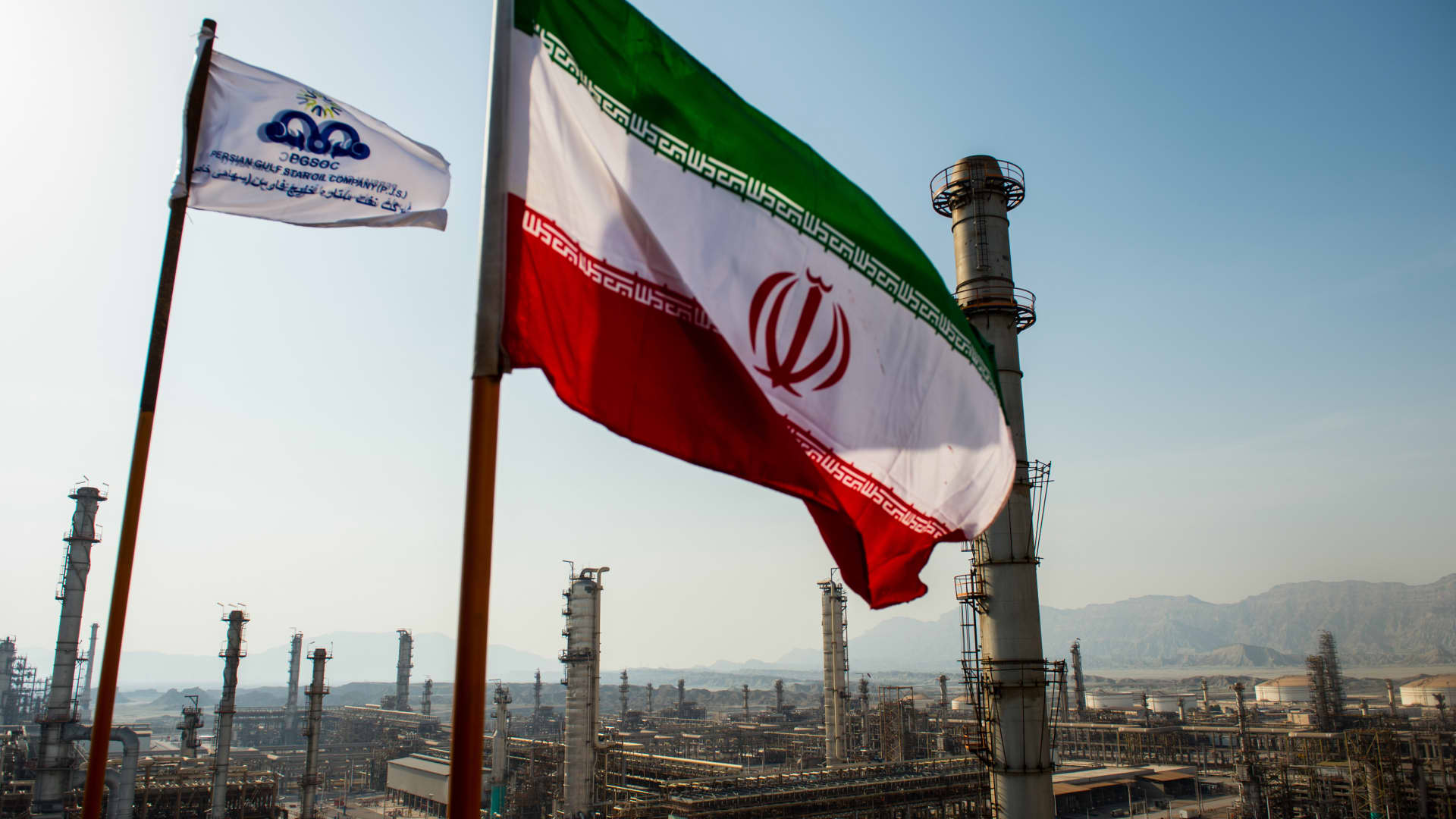
The Iranian flag above the new Phase 3 facility at the Persian Gulf Star gas condensate refinery in Bandar Abbas, Iran, in 2019.
Ali Mohammadi | Bloomberg | Getty Images
If investors only looked at the price of oil at the end of this week, they wouldn’t have known that Israel and Iran, OPEC’s third-largest crude producer, briefly stood on the brink of an unprecedented war.
U.S. crude oil and global benchmark Brent finished out the week about 3% lower, despite the fact that Iran and Israel traded direct strikes against each other’s territory for the first time. Fears that oil prices could shoot to $100 a barrel or above did not materialize.
In fact, U.S. oil futures closed Friday at $83.14 a barrel which was the lowest settlement price since late March, days before the current spiral of escalation began with Israel’s strike on an Iranian diplomatic compound in Damascus, Syria on April 1.
Futures fell for three days following Iran’s missile and drone barrage against Israel last weekend, and prices settled only slightly higher after Israel struck back on Friday.
Investors seem to believe that Israel’s limited retaliatory strike, which does not appear to have caused any significant damage or casualties, provided Iran with an off ramp to refrain from counterattacking.
The market has essentially erased the risk premium associated with the Iran-Israel tensions after traders bid up prices last week on war fears.
“Traders aren’t buying that either Israel or Iran is actually interested in escalating the tensions and are merely engaged in largely symbolic, face-saving exercises,” said Manish Raj, managing director at Velandara Energy Partners. “These skirmishes did not impress the oil markets, which believe that no disruption to oil flows will occur.”
The bar for war is high
Oil markets were most worried about Israel striking one of Iran’s nuclear facilities, which would have required Tehran to hit back, according John Kilduff, founding partner at Again Capital. International pressure on Israel to demonstrate restraint appears to have paid off. The International Atomic Energy Agency confirmed Friday there was no damage to Iran’s nuclear sites.
“We are therefore ready to cautiously conclude that the cycle of escalation between Israel and Iran is over, at least as far as direct attacks against each other are involved,” Marko Papic, chief strategist at the Clocktower Group, told clients in a Friday note. Papic said a sustained war between Israel and Iran is difficult to imagine and may even be practically impossible.

WTI and Brent prices over the past month
“The two countries are separated by considerable distances given the power projection capabilities of their militaries,” Papic told clients. “As such, Israel’s limited response to Iran may not be merely a diplomatic choice due to U.S. pressure. Instead, it may be a function of material constraints as well.”
Kilduff told CNBC’s “Squawk Box” on Friday that the bar is very high in the Middle East for all-out war to break out, choking off oil supplies.
“Over the years – really the decades now – these attacks come, they are dealt with, they are handled diplomatically and we don’t lose any barrels of oil,” Kilduff said.
Rising Mideast risk
But the oil market and the world at large may have simply had good luck this week. Israel and its U.S.-led allies managed to shoot down nearly all of the more than 300 missiles and drones launched by Iran, which likely reduced pressure on the Netanyahu government to strike back with dramatic force.
But Iran intended for the missiles and drones to do significant damage, said Tom Donilon, who served as former President Barack Obama’s national security advisory. The Islamic Republic simply did not anticipate that the coalition’s air defenses would prove so effective at shielding Israel, Donilon said.
“There is no guarantee that you get a 99% success rate on one of these things every time that it happens,” Donilon cautioned at the Columbia Global Energy Summit in New York City on Tuesday. Although the situation hasn’t escalated in the short term, the Iranian attack has changed the region, he said.
“Long-term it is a structural increase in the risk profile in the region,” Donilon said.
Focus remains on the the Strait of Hormuz, the narrow body of water through which 19 million barrels of oil pass daily from the Persian Gulf to the global market. The price of global benchmark Brent crude oil could surge to $130 a barrel if there’s a major disruption in the strait, according to Rapidan Energy Group.
“When you’re talking about Iran, everybody’s focusing on the Strait of Hormuz, rightly so, even though it’s hard to see Iran affecting that because they rely on it so much” themselves to export oil, Kilduff said.
Blocking the strait is off the table for the Iranians, Kilduff said, but if they started seizing vessels the oil market would take notice.
“The oil market would focus like a laser beam on that because to the extent tankers then start to avoid the region, stop transporting oil to avoid any kind of direct conflict or interaction with the Iranian naval forces, then yes, we’re back in the soup,” Kilduff said.
